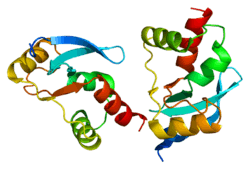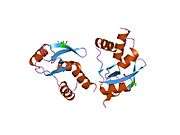DACH1
| View/Edit Human | View/Edit Mouse |
Dachshund homolog 1, also known as DACH1, is a protein which in humans is encoded by the DACH1 gene. DACH1 has been shown to interact with UBE2I,[4][5] Smad4 and NCoR.[6]
Structure
This protein coding gene has 760 amino acid protein, and an observed molecular weight of 52 kDa. Dachshund Family transcription factor 1 is encoded by DACH gene, who spans 400kDa and is encoded by 12 exons. This gene is located, in humans, in chromosome 13 (13q22). It encodes a chromatin-associated protein that associates with other DNA-binding transcription factors to regulate gene expression and cell fate determination during development.[10][11][12][13][14][15]
Multiple transcript variants encoding different isoforms have been found for this gene. DACH mRNA was detected in multiple human tissues, including kidney and heart.[17]
It finds in nucleus of the cells, and it is considered a cell fate determination factor.[10]
Dachshund domain 1 (DD1, also known as Box-N) has a predicted helix–turn–helix family structure.[18][19]
The X-ray crystal structure of the human DACH1 Box-N illustrates that the DACH1 protein contains a domain that is conserved with the pro-oncogenes ski/sno oncogenes, which form an α/β structure similar to that found in the winged helix/forkhead subgroup of DNA binding proteins.[19][20]
This protein is widely expressed. We can find it in bone marrow, brain, colon, eye, heart, kidney, leucocyte, liver, lung, pancreas, pineal gland, placenta, prostate, retina, skeletal muscle, small intestine and spleen.[10][21]
Function
This gene is similar to the D. melanogaster dachshund gene, which encodes a nuclear factor essential for determining cell fates in the eye, leg, and nervous system of the fly. It is a member of the Ski gene family and is thought to be involved in eye development. Four alternatively spliced transcripts encoding different isoforms have been described for this gene.[9]
DACH1 protein is able to prevent the proliferation of cancerous cells due to being a natural repressor of estrogen receptors in the normal function of mammary tissue.[23]
DACH1 also has other functions related to cell activity. It down regulates transcriptions from RNA polymerase II promoter in order to bind the factor activity which is involved in negative regulation of transcription. This protein is able to do this by interacting selectively and non-covalently with a sequence of DNA which is near the core promoter for RNA polymerase II. It also interacts with this sequence of DNA to bind the activity of the factor involved in the transcription in preinitiation complex assembly. Another important function that is related with this protein is cell proliferation. This implies that the cells will start to reproduce increasing the cell population. DACH1 plays an important role on this precursor of cell proliferation in retinal and pituitary.[24]
DACH1 is responsible for the inhibition of cell migration. Some other processes that DACH1 protein regulates by reducing the frequency, are the transcription of a specific gene, the synthesis process of DNA and the reproduction of fibroblast cells.[25]
This protein is also responsible of the gas exchange of oxygen and carbon dioxide between the nature and the organism.[26]
Disease relevance
DACH1 is envolved in two principal diseases:
Breast tumor growth

DACH1 is a cell fate determination factor that inhibits Cyclin D1 and thereby inhibit cell proliferation of Breast Tumor.
Normal cells and some breast cancer cells have receptors that bind estrogen and progesterone. These two hormones often promote the growth of breast cancer cells.
Approximately 70% of breast cancers are ER+, which means that these estrogen receptors are present. DACH1 expression decreases when the cancer is more invasive and the level of estrogen is high.
The role of DACH1 in the inhibition of oncogene-induced cellular migration and metastasis is well established in breast cancer cells.
Dach1 inhibited oncogene-mediated breast oncogenesis, blocking breast cancer epithelial cell DNA synthesis, colony formation, growth in Matrigel, and tumor growth in mice.
Nephropathy
DACH1 plays an important role in retinal and pituitary precursor cell proliferation. Dach1 regulates early progenitor cell proliferation during mammalian retinogenesis and pituitary development by directly repressing cyclin-dependent kinase inhibitors.
Dach1 is highly expressed in the adult podocyte, with transcripts showing an approximate ten fold enrichment compared to total kidney cortex. It is also more widely expressed in the earlier developing kidney, but again including definite podocyte expression.
The Dach1 mutant mice exhibit early postnatal death, although no developmental defects were detected in any organ system examined, including kidneys.
References
- ↑ "Diseases that are genetically associated with DACH1 view/edit references on wikidata".
- ↑ "Human PubMed Reference:".
- ↑ "Mouse PubMed Reference:".
- ↑ Rual JF, Venkatesan K, Hao T, Hirozane-Kishikawa T, Dricot A, Li N, et al. (October 2005). "Towards a proteome-scale map of the human protein-protein interaction network". Nature. 437 (7062): 1173–8. doi:10.1038/nature04209. PMID 16189514.
- ↑ Machon O, Backman M, Julin K, Krauss S (October 2000). "Yeast two-hybrid system identifies the ubiquitin-conjugating enzyme mUbc9 as a potential partner of mouse Dac". Mechanisms of Development. 97 (1-2): 3–12. doi:10.1016/S0925-4773(00)00402-0. PMID 11025202.
- ↑ Wu K, Yang Y, Wang C, Davoli MA, D'Amico M, Li A, Cveklova K, Kozmik Z, Lisanti MP, Russell RG, Cvekl A, Pestell RG (December 2003). "DACH1 inhibits transforming growth factor-beta signaling through binding Smad4". The Journal of Biological Chemistry. 278 (51): 51673–84. doi:10.1074/jbc.M310021200. PMID 14525983.
- ↑ Hammond KL, Lettice LA, Hill RE, Lee M, Boyle S, Hanson IM (January 1999). "Human (DACH) and mouse (Dach) homologues of Drosophila dachshund map to chromosomes 13q22 and 14E3, respectively". Genomics. 55 (2): 252–253. doi:10.1006/geno.1998.5662. PMID 9933575.
- ↑ Kozmik Z, Cvekl A (July 1999). "Localization of the human homologue of the Drosophila dachshund gene (DACH) to chromosome 13q21". Genomics. 59 (1): 110–111. doi:10.1006/geno.1999.5797. PMID 10395809.
- 1 2 "Entrez Gene: DACH1 dachshund homolog 1 (Drosophila)".
- 1 2 3 "DACH1 cdna clone". Mybiosource. Retrieved 18 October 2016.
- ↑ "DACH1 (dachshund family transcription factor 1)". Atlas of Genetics and Cytogenetics in Oncology and Haematology. Retrieved 16 October 2016.
- ↑ "DACHSHUND, DROSOPHILA, HOMOLOG OF, 1; DACH1". OMIM. Retrieved 18 October 2016.
- ↑ Ayres JA, Shum L, Akarsu AN, Dashner R, Takahashi K, Ikura T, Slavkin HC, Nuckolls GH (September 2001). "DACH: genomic characterization, evaluation as a candidate for postaxial polydactyly type A2, and developmental expression pattern of the mouse homologue". Genomics. 77 (1-2): 18–26. doi:10.1006/geno.2001.6618. PMID 11543628.
- ↑ "DACH1 (human)". PhosphoSitePlus. Retrieved 16 October 2016.
- ↑ "DACH1 dachshund family transcription factor 1 [ Homo sapiens (human) ]". NCBI. Retrieved 20 October 2016.
- ↑ "DACH1 Gene". GeneCards. Retrieved 20 October 2016.
- ↑ "DACH1_HUMAN". MobiDB. Retrieved 20 October 2016.
- ↑ "Human Gene DACH1". UCSC Genome Browser. Retrieved 20 October 2016.
- 1 2 Kim SS, Zhang RG, Braunstein SE, Joachimiak A, Cvekl A, Hegde RS (2003). "Structure of the retinal determination protein Dachshund reveals a DNA binding motif". Structure. 10 (6): 787–795. doi:10.1016/S0969-2126(02)00769-4. PMID 12057194.
- ↑ Liu Y, Han N, Zhou S, Zhou R, Yuan X, Xu H, Zhang C, Yin T, Wu K (2016). "The DACH/EYA/SIX gene network and its role in tumor initiation and progression". International Journal of Cancer. 138 (5): 1067–75. doi:10.1002/ijc.29560. PMID 26096807.
- ↑ "human protein reference database". Retrieved 20 October 2016.
- ↑ "DACH1 - Dachshund homolog 1 - Homo sapiens (Human) - DACH1 gene & protein". www.uniprot.org. Retrieved 2016-10-22.
- ↑ Popov VM, Zhou J, Shirley LA, Quong J, Yeow WS, Wright JA, Wu K, Rui H, Vadlamudi RK, Jiang J, Kumar R, Wang C, Pestell RG (2009). "The cell fate determination factor DACH1 is expressed in estrogen receptor-alpha-positive breast cancer and represses estrogen receptor-alpha signaling". Cancer Research. 69 (14): 5752–60. doi:10.1158/0008-5472.CAN-08-3992. PMC 3244171
 . PMID 19605405.
. PMID 19605405. - ↑ "DACH1 - dachshund family transcription factor 1". Wikigenes. Retrieved 16 October 2016.
- ↑ "UniProtKB - Q9UI36 (DACH1_HUMAN)". UniProt. Retrieved 16 October 2016.
- ↑ "UniProtKB - Q9UI36 (DACH1_HUMAN)". UniProt. Retrieved 17 October 2016.
Further reading
- Hammond KL, Hanson IM, Brown AG, Lettice LA, Hill RE (2003). "Mammalian and Drosophila dachshund genes are related to the Ski proto-oncogene and are expressed in eye and limb". Mech. Dev. 74 (1–2): 121–131. doi:10.1016/S0925-4773(98)00071-9. PMID 9651501.
- Hammond KL, Lettice LA, Hill RE, Lee M, Boyle S, Hanson IM (1999). "Human (DACH) and mouse (Dach) homologues of Drosophila dachshund map to chromosomes 13q22 and 14E3, respectively". Genomics. 55 (2): 252–253. doi:10.1006/geno.1998.5662. PMID 9933575.
- Kozmik Z, Cvekl A (1999). "Localization of the human homologue of the Drosophila dachshund gene (DACH) to chromosome 13q21". Genomics. 59 (1): 110–111. doi:10.1006/geno.1999.5797. PMID 10395809.
- Kozmik Z, Pfeffer P, Kralova J, Paces J, Paces V, Kalousova A, Cvekl A (1999). "Molecular cloning and expression of the human and mouse homologues of the Drosophila dachshund gene". Dev. Genes Evol. 209 (9): 537–545. doi:10.1007/s004270050286. PMID 10502110.
- Machon O, Backman M, Julin K, Krauss S (2001). "Yeast two-hybrid system identifies the ubiquitin-conjugating enzyme mUbc9 as a potential partner of mouse Dac". Mech. Dev. 97 (1–2): 3–12. doi:10.1016/S0925-4773(00)00402-0. PMID 11025202.
- Ayres JA, Shum L, Akarsu AN, Dashner R, Takahashi K, Ikura T, Slavkin HC, Nuckolls GH (2001). "DACH: genomic characterization, evaluation as a candidate for postaxial polydactyly type A2, and developmental expression pattern of the mouse homologue". Genomics. 77 (1–2): 18–26. doi:10.1006/geno.2001.6618. PMID 11543628.
- Ozaki H, Watanabe Y, Ikeda K, Kawakami K (2002). "Impaired interactions between mouse Eyal harboring mutations found in patients with branchio-oto-renal syndrome and Six, Dach, and G proteins". J. Hum. Genet. 47 (3): 0107–0116. doi:10.1007/s100380200011. PMID 11950062.
- Ikeda K, Watanabe Y, Ohto H, Kawakami K (2002). "Molecular interaction and synergistic activation of a promoter by Six, Eya, and Dach proteins mediated through CREB binding protein". Mol. Cell. Biol. 22 (19): 6759–6766. doi:10.1128/MCB.22.19.6759-6766.2002. PMC 134036
 . PMID 12215533.
. PMID 12215533. - Wu K, Yang Y, Wang C, Davoli MA, D'Amico M, Li A, Cveklova K, Kozmik Z, Lisanti MP, Russell RG, Cvekl A, Pestell RG (2004). "DACH1 inhibits transforming growth factor-beta signaling through binding Smad4". J. Biol. Chem. 278 (51): 51673–51684. doi:10.1074/jbc.M310021200. PMID 14525983.
- Nobrega MA, Ovcharenko I, Afzal V, Rubin EM (2003). "Scanning human gene deserts for long-range enhancers". Science. 302 (5644): 413–413. doi:10.1126/science.1088328. PMID 14563999.
- Li X, Oghi KA, Zhang J, Krones A, Bush KT, Glass CK, Nigam SK, Aggarwal AK, Maas R, Rose DW, Rosenfeld MG (2003). "Eya protein phosphatase activity regulates Six1-Dach-Eya transcriptional effects in mammalian organogenesis". Nature. 426 (6964): 247–254. doi:10.1038/nature02083. PMID 14628042.
- Martini SR, Davis RL (2005). "The dachshund gene is required for the proper guidance and branching of mushroom body axons in Drosophila melanogaster". J. Neurobiol. 64 (2): 133–144. doi:10.1002/neu.20130. PMID 15818552.
- Wu K, Li A, Rao M, Liu M, Dailey V, Yang Y, Di Vizio D, Wang C, Lisanti MP, Sauter G, Russell RG, Cvekl A, Pestell RG (2006). "DACH1 is a cell fate determination factor that inhibits cyclin D1 and breast tumor growth". Mol. Cell. Biol. 26 (19): 7116–7129. doi:10.1128/MCB.00268-06. PMC 1592900
 . PMID 16980615.
. PMID 16980615.



